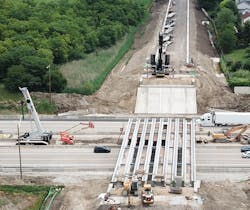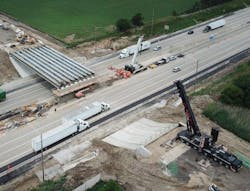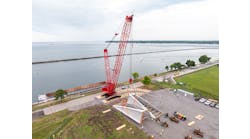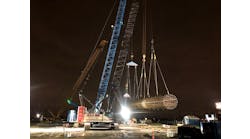Stearns School Road Bridge replaced in ongoing Illinois Tollway upgrade
The multiyear, multibillion-dollar project to upgrade the Illinois Tollway made its way to Gurnee, Illinois, this summer and the aging Stearns School Road Bridge, which goes over I-94.
Work called for replacing the 70-year-old bridge with a new three-lane precast concrete structure that also includes access for bicyclists and pedestrians.
Metropolitan Steel handled bridge construction with Dunnet Bay Construction as general contractor. Metropolitan Steel secured cranes and operators from Central Contractors Service, a member of the ALL Family of Companies.
Central Contractors Service supplied a 250-USt Linkbelt TCC-2500 hydraulic crawler and 550-USt Liebherr LTM 1450-8.1 all-terrain (AT) crane for the four-day project.
The scope of work called for 18 precast girders to be set, each 139 ft long and weighing approximately 158,000 lb. Setting each girder required a dual pick, with the Link-Belt TCC-2500 crawler positioned in the median on I-94 below and the Liebherr LTM 1450 above on the bridge abutment.
Girders were trucked to the site on I-94, with the truck pulling as far onto the shoulder as possible. “These were large girders that took up half the highway,” said Dave Budzius, project manager for Metropolitan Steel. “The key was maintaining masterful logistics—get the girders in, make the pick, off-load, swing, walk, and set.”
Two crane operators from Central Contractors Service executed the meticulous process of picking and setting. First, the rigging crew prepared the girder for the lift. The Liebherr AT, positioned above on the abutment, connected first. Then the crawler, in the median below, picked the back end of the piece. Next, the operators would swing the girder in tandem, then the crawler had to walk up to place the girder in its final position.
Budzius said the hydraulic crawler’s ability to boom down while walking was advantageous for this project. “It has the capacity and ability to walk with weight on the hook just like a lattice boom, but can get into tighter spots due to the ability to lower the boom. With a lattice boom, obviously, you’re at a fixed height. That added flexibility made the lifts go that much more smoothly.”
Once the team got into a rhythm, Budzius estimates that, after rigging was complete, setting each girder took around 45 minutes, even with the TCC-2500 having to walk with its load. Even more impressive, work was done at night as local law enforcement directed vehicular traffic.
The four-day turnaround was tight, but easily achieved via careful planning, selection of the right equipment, and cooperative weather.
This is not the last Illinois Tollway project that Metropolitan Steel and Central Contractors Service will collaborate on. Both entities will be working on another phase of work later this summer.
-----------
Editor's Note: Scranton Gillette Communications and the SGC Infrastructure Group are not liable for the accuracy, efficacy and validity of the claims made in this piece. The views expressed in this content do not reflect the position of the Roads & Bridges' Editorial Team.




